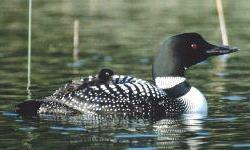 The Biodiversity Research Institute (BRI) of Gorham, Maine announced yesterday that it will begin the largest loon conservation study in North America.
The Biodiversity Research Institute (BRI) of Gorham, Maine announced yesterday that it will begin the largest loon conservation study in North America.
The announcement was made in Wyoming, an interesting choice, since it is not exactly a hotbed of loon activity. Wyoming is, however, home to one of the many ventures of the study’s funder, Joe Ricketts. BRI was awarded a $6.5 M grant from the new Ricketts Conservation Foundation for the study.
A press release about the announcement sent to Society of Enviromental Journalist members said: “Underlying the Foundation’s mission is the reality that government no longer has sufficient resources to deal effectively with the growing environmental challenges we face. As a result, private individuals and corporations must increasingly shoulder the responsibility of conserving our wildlife and wilderness areas. www.joericketts.com” (The website says, among other things, that Ricketts is a part owner of the Chicago Cubs.)
The press invitation also says: “The loon is a key bioindicator of aquatic integrity for lakes and near shore marine ecosystems. These iconic birds are becoming more exposed and susceptible to serious threats from type E botulism, mercury pollution, lead poisoning, oil spills, and over development.”
Visit the BRI website’s loon program page, here.
Photo: Loon, courtesy of the State of Minnesota, where the loon is the state bird.

 Two stories today focus on two different states’ efforts to get lead out of the environment.
Two stories today focus on two different states’ efforts to get lead out of the environment.